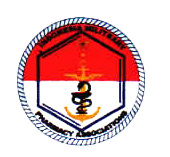PELUANG DAN TANTANGAN PENGEMBANGAN SENYAWA ASTAXANTHIN DAN BENTUK ESTERNYA UNTUK MENDUKUNG KETAHANAN PANGAN NASIONAL
(1) Dinas Ketahanan Pangan Provinsi Sulawesi Selatan
(2) Fakultas Farmasi, Universitas Indonesia
(3) Lembaga Ketahanan Nasional Republik Indonesia
(4) Fakultas Ilmu Sosial dan Ilmu Politik, Universitas Hasanuddin
(*) Corresponding Author
Abstract
Ketahanan pangan merupakan isu multidimensi kompleks yang berperan dalam kesehatan masyarakat. Pilar yang mendukung ketahanan pangan nasional meliputi ketersediaan, aksesibilitas, dan pemanfaatan pangan, termasuk mengembangkan kualitas pangan untuk kesehatan masyarakat/sumber daya manusia. Astaxanthin, senyawa bioaktif yang ditemukan pada krustasea, ikan, dan mikroalga serta bentuk esternya, memiliki manfaat kesehatan signifikan dan berpotensi meningkatkan kualitas pangan masyarakat melalui fortifikasi. Namun, hingga kini, kajian komprehensif mengenai peluang dan tantangan pengembangan astaxanthin dalam konteks ketahanan pangan masih terbatas. Riset ini bertujuan mengulas aplikasi senyawa astaxanthin dan bentuk esternya dengan menjabarkan hal-hal yang berkaitan dengan sumber bahan, aplikasi dalam formulasi pangan fungsional, peluang, dan tantangan sebagai senyawa fortifikasi pangan untuk meningkatkan ketahanan pangan. Penelitian ini merupakan literature review dengan menggunakan studi pustaka yang relevan berdasarkan pencarian kata kunci yang sesuai dengan topik pembahasan. Hasil penelitian menunjukkan bahwa senyawa astaxanthin dan bentuk esternya telah diformulasi sebagai pangan fungsional untuk menunjang kesehatan serta dapat dimanfaatkan sebagai antioksidan alami dalam produk dan meningkatkan nutrisi pada pangan hewani. Tantangan utama pengembangan astaxanthin meliputi tingginya biaya produksi, stabilitas senyawa, serta bioavailabilitasnya dalam formulasi. Penelitian ini berkontribusi pada pengembangan astaxanthin dalam konteks ketahanan pangan yang memiliki potensi besar untuk meningkatkan kualitas hidup masyarakat dan mendukung ketahanan pangan nasional.
Keywords
Full Text:
PDFReferences
Ambati, R. R., Moi, P. S., Ravi, S., & Aswathanarayana, R. G. (2014). Astaxanthin: Sources, extraction, stability, biological activities and its commercial applications—A review. Marine Drugs, 12(1), 128–152. https://doi.org/10.3390/md12010128
Aoi, W., Maoka, T., Abe, R., Fujishita, M., & Tominaga, K. (2018). Comparison of the effect of non-esterified and esterified astaxanthins on endurance performance in mice. Journal of Clinical Biochemistry and Nutrition, 62(2), 161–166. https://doi.org/10.3164/jcbn.17-89
Badan Pangan Nasional. (2023). Indeks Ketahanan Pangan Nasional 2023. Deputi Bidang Kerawanan Pangan dan Gizi.
Berek, R. B. (2018). Peran Food and Agriculture Organization (Fao) Dalam Meningkatkan Ketahanan Pangan Di Provinsi Nusa Tenggara Timur Melalui Program Pertanian Konservasi. Global Political Studies Journal, 2(2), 161–176. https://doi.org/10.34010/gpsjournal.v2i2.2029
Buesen, R., Schulte, S., Strauss, V., Treumann, S., Becker, M., Gröters, S., Carvalho, S., & Ravenzwaay, B. van. (2015). Safety assessment of [3S, 3′S]-astaxanthin – Subchronic toxicity study in rats. Food and Chemical Toxicology, 81, 129–136. https://doi.org/10.1016/j.fct.2015.04.017
Dang, Y., Li, Z., & Yu, F. (2024). Recent Advances in Astaxanthin as an Antioxidant in Food Applications. Antioxidants, 13(7), Article 7. https://doi.org/10.3390/antiox13070879
Fukuzawa, K., Inokami, Y., Tokumura, A., Terao, J., & Suzuki, A. (1998). Rate constants for quenching singlet oxygen and activities for inhibiting lipid peroxidation of carotenoids and α-tocopherol in liposomes. Lipids, 33(8), 751–756. https://doi.org/10.1007/s11745-998-0266-y
Gómez-Estaca, J., Calvo, M. M., Álvarez-Acero, I., Montero, P., & Gómez-Guillén, M. C. (2017). Characterization and storage stability of astaxanthin esters, fatty acid profile and α-tocopherol of lipid extract from shrimp (L. vannamei) waste with potential applications as food ingredient. Food Chemistry, 216, 37–44. https://doi.org/10.1016/j.foodchem.2016.08.016
Goto, S., Kogure, K., Abe, K., Kimata, Y., Kitahama, K., Yamashita, E., & Terada, H. (2001). Efficient radical trapping at the surface and inside the phospholipid membrane is responsible for highly potent antiperoxidative activity of the carotenoid astaxanthin. Biochimica et Biophysica Acta (BBA) - Biomembranes, 1512(2), 251–258. https://doi.org/10.1016/S0005-2736(01)00326-1
Hapsari, N. I., & Rudiarto, I. (2017). Faktor-Faktor yang Mempengaruhi Kerawanan dan Ketahanan Pangan dan Implikasi Kebijakannya di Kabupaten Rembang. Jurnal Wilayah Dan Lingkungan, 5(2), 125. https://doi.org/10.14710/jwl.5.2.125-140
Hossain, A. K. M., Brennan, M. A., Mason, S. L., Guo, X., Zeng, X. A., & Brennan, C. S. (2017). The effect of astaxanthin-rich microalgae “haematococcus pluvialis” and wholemeal flours incorporation in improving the physical and functional properties of cookies. Foods, 6(8), 1–10. https://doi.org/10.3390/foods6080057
Huang, L., Zhang, L., Li, R., & Liang, P. (2021). Formulation and optimization of astaxanthin nanoemulsions with marine phospholipids derived from large yellow croaker (Larimichthys crocea) roe. https://doi.org/10.15586/ijfs.v33i3.2029
Kementerian Kelautan dan Perikanan Republik Indonesia. (2023). Profil Pasar Udang. Direktur Jenderal Penguatan Daya Saing Produk Kelautan dan Perikanan.
Kusmayadi, A., Leong, Y. K., Yen, H. W., Huang, C. Y., & Chang, J. S. (2021). Microalgae as sustainable food and feed sources for animals and humans – Biotechnological and environmental aspects. Chemosphere, 271, 129800. https://doi.org/10.1016/j.chemosphere.2021.129800
Li, J., Zhu, D., Niu, J., Shen, S., & Wang, G. (2011). An economic assessment of astaxanthin production by large scale cultivation of Haematococcus pluvialis. Biotechnology Advances, 29(6), 568–574. https://doi.org/10.1016/j.biotechadv.2011.04.001
Liu, J., Sun, Z., Gerken, H., Liu, Z., Jiang, Y., & Chen, F. (2014). Chlorella zofingiensis as an alternative microalgal producer of astaxanthin: Biology and industrial potential. Marine Drugs, 12(6), 3487–3515. https://doi.org/10.3390/md12063487
Martin, H. D., Ruck, C., Schmidt, M., Sell, S., Beutner, S., Mayer, B., & Walsh, R. (1999). Chemistry of carotenoid oxidation and free radical reactions. Pure and Applied Chemistry, 71(12), 2253–2262. https://doi.org/10.1351/PAC199971122253/MACHINEREADABLECITATION/RIS
Martínez-Delgado, A. A., Khandual, S., & Villanueva–Rodríguez, S. J. (2017). Chemical stability of astaxanthin integrated into a food matrix: Effects of food processing and methods for preservation. Food Chemistry, 225, 23–30. https://doi.org/10.1016/j.foodchem.2016.11.092
McNulty, H. P., Byun, J., Lockwood, S. F., Jacob, R. F., & Mason, R. P. (2007). Differential effects of carotenoids on lipid peroxidation due to membrane interactions: X-ray diffraction analysis. Biochimica et Biophysica Acta (BBA) - Biomembranes, 1768(1), 167–174. https://doi.org/10.1016/J.BBAMEM.2006.09.010
Nishida, Y., Berg, P. C., Shakersain, B., Hecht, K., Takikawa, A., Tao, R., Kakuta, Y., Uragami, C., Hashimoto, H., Misawa, N., & Maoka, T. (2023). Astaxanthin: Past, Present, and Future. Marine Drugs, 21(10), Article 10. https://doi.org/10.3390/md21100514
Nishida, Y., Yamashita, E., & Miki, W. (2007). Quenching activities of common hydrophilic and lipophilic antioxidants against singlet oxygen using chemiluminescence detection system. Carotenoid Sci, 11, 16–20.
Pan, X., Wang, B., Duan, R., Jia, J., Li, J., Xiong, W., Ling, X., Chen, C., Huang, X., Zhang, G., & Lu, Y. (2020). Enhancing astaxanthin accumulation in Xanthophyllomyces dendrorhous by a phytohormone: Metabolomic and gene expression profiles. Microbial Biotechnology, 13(5), 1446–1460. https://doi.org/10.1111/1751-7915.13567
Panagiotakopoulos, I., Karantonis, H. C., Kartelias, I. G., & Nasopoulou, C. (2023). Ultrasonic-Assisted Extraction of Astaxanthin from Shrimp By-Products Using Vegetable Oils. Marine Drugs, 21(9), Article 9. https://doi.org/10.3390/md21090467
Saleh, N., & Widodo, Y. (2008). Profil Dan Peluang Pengembangan Ubi Jalar Untuk Mendukung Ketahanan Pangan dan Agroindustri. Buletin Palawija, 15, 21–30.
Shu, G., Khalid, N., Chen, Z., Neves, M. A., Barrow, C. J., & Nakajima, M. (2018). Formulation and characterization of astaxanthin-enriched nanoemulsions stabilized using ginseng saponins as natural emulsifiers. In Food Chemistry (Vol. 255, pp. 67–74). https://doi.org/10.1016/j.foodchem.2018.02.062
Šimat, V., Rathod, N. B., Čagalj, M., Hamed, I., & Generalić Mekinić, I. (2022). Astaxanthin from Crustaceans and Their Byproducts: A Bioactive Metabolite Candidate for Therapeutic Application. Marine Drugs, 20(3), 206. https://doi.org/10.3390/md20030206
Simatupang, P. (2007). A Critical Review on Paradigm and Framework of National Food Security Policy. Forum Penelitian AGRO EKONOMI, 25(1), 1–18.
Snell, T. W., & Carberry, J. (2022). Astaxanthin Bioactivity Is Determined by Stereoisomer Composition and Extraction Method. Nutrients, 14(7). https://doi.org/10.3390/nu14071522
Stachowiak, B., & Szulc, P. (2021). Astaxanthin for the Food Industry. Molecules, 26(9). https://doi.org/10.3390/MOLECULES26092666
Sun, J., Yan, J., Dong, H., Gao, K., Yu, K., He, C., & Mao, X. (2023). Astaxanthin with different configurations: Sources, activity, post modification, and application in foods. Current Opinion in Food Science, 49, 100955. https://doi.org/10.1016/j.cofs.2022.100955
Suryana, A. (2023). Menuju Ketahanan Pangan Indonesia Berkelanjutan 2025: Tantangan dan Penanganannya. Forum Penelitian AGRO EKONOMI, 32(2).
Todorović, B., Grujić, V. J., Krajnc, A. U., Kranvogl, R., & Ambrožič-Dolinšek, J. (2021). Identification and Content of Astaxanthin and Its Esters from Microalgae Haematococcus pluvialis by HPLC-DAD and LC-QTOF-MS after Extraction with Various Solvents. Plants (Basel, Switzerland), 10(11). https://doi.org/10.3390/plants10112413
Turck, D., Castenmiller, J., de Henauw, S., Hirsch-Ernst, K. I., Kearney, J., Maciuk, A., Mangelsdorf, I., McArdle, H. J., Naska, A., Pelaez, C., Pentieva, K., Siani, A., Thies, F., Tsabouri, S., Vinceti, M., Cubadda, F., Engel, K. H., Frenzel, T., Heinonen, M., … Knutsen, H. K. (2020). Safety of astaxanthin for its use as a novel food in food supplements. EFSA Journal, 18(2), e05993. https://doi.org/10.2903/J.EFSA.2020.5993
Villaró, S., Ciardi, M., Morillas‐españa, A., Sánchez‐zurano, A., Acién‐fernández, G., & Lafarga, T. (2021). Microalgae Derived Astaxanthin: Research and Consumer Trends and Industrial Use as Food. Foods 2021, Vol. 10, Page 2303, 10(10), 2303. https://doi.org/10.3390/FOODS10102303
Wang, J., Liu, S., Wang, H., Xiao, S., Li, C., Li, Y., & Liu, B. (2019). Xanthophyllomyces dendrorhous-derived astaxanthin regulates lipid metabolism and gut microbiota in obese mice induced by a high-fat diet. Marine Drugs, 17(6), 1–10. https://doi.org/10.3390/md17060337
Wang, Y., & Peng, J. (2008). Growth-associated biosynthesis of astaxanthin in heterotrophic Chlorella zofingiensis (Chlorophyta). World Journal of Microbiology and Biotechnology, 24(9), 1915–1922. https://doi.org/10.1007/s11274-008-9692-8
Xie, X., Zhong, M., Huang, X., Yuan, X., Mahna, N., Mussagy, C. U., & Ren, M. (2024). Astaxanthin biosynthesis for functional food development and space missions. Critical Reviews in Biotechnology, 1–15. https://doi.org/10.1080/07388551.2024.2410364
Yamashita, E. (2013). Astaxanthin as a medical food. Functional Foods in Health and Disease, 3(7), 254–258. https://doi.org/10.31989/ffhd.v3i7.49
Yamashita, E. (2015). Let astaxanthin be thy medicine. PharmaNutrition, 3(4), 115–122. https://doi.org/10.1016/j.phanu.2015.09.001
Zhang, Z., Huang, J. J., Sun, D., Lee, Y., & Chen, F. (2017). Two-step cultivation for production of astaxanthin in Chlorella zofingiensis using a patented energy-free rotating floating photobioreactor (RFP). Bioresource Technology, 224, 515–522. https://doi.org/10.1016/j.biortech.2016.10.081
DOI: https://doi.org/10.33172/jpbh.v14i3.19734
Copyright (c) 2024 Agus Takariyawati, Fatimah Azzahra, Zenab Zaenab, M. Yusuf Samad
INDEXED BY:
Office Address:
Lembaga Penelitian dan Pengabdian Kepada Masyarakat
Republic of Indonesia Defense University
Jl. Salemba Raya No.14, Paseban,Jakarta Pusat, Daerah Khusus Ibukota Jakarta 10440, Indonesia
Email: jurnal.unhan@idu.ac.id
Creative Commons Attribution (CC-BY-NC-SA)

This work is licensed under a Creative Commons Attribution-NonCommercial-ShareAlike 4.0 International License.
View Jurnal Pertahanan dan Bela Negara Stats





